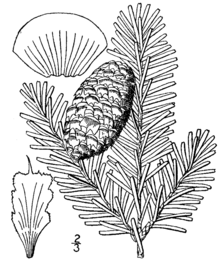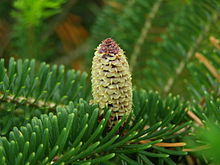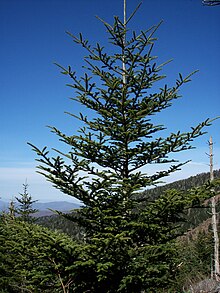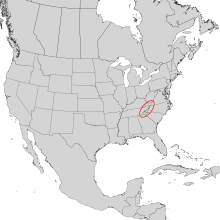Fraser fir
| Fraser fir | ||||||||||||
|---|---|---|---|---|---|---|---|---|---|---|---|---|

Fraser fir ( Abies fraseri ) |
||||||||||||
| Systematics | ||||||||||||
|
||||||||||||
| Scientific name | ||||||||||||
| Abies fraseri | ||||||||||||
| ( Pursh ) Poir. |
The Fraser fir ( Abies fraseri ), and Fraser fir mentioned, is a plant of the genus of fir ( Abies ) in the family of Pinaceae (Pinaceae). It occurs naturally in the southern Appalachian Mountains in eastern North America .
description
Appearance
The Fraser fir is an evergreen tree that reaches heights of 15 meters (sometimes 25 meters) with a trunk diameter ( BHD ) of 50 centimeters. The growth form of the crown is narrowly conical and relatively open. The first-order branches are horizontal, rising towards the tree top. Branches of the second order also grow horizontally to slightly ascending. The seedling has five cotyledons ( cotyledons ).
Bark, buds and needles
The bark of young trees is smooth and brown with resin bumps, with increasing age it becomes gray, rough and scaly. The bark of annual twigs is pale yellowish to brown, that in the second year is dark brown, it is slightly grooved and hairy reddish. The resinous buds of the Fraser fir are egg-shaped with a length of about 4 millimeters and a width of about 3 millimeters. The buds are dark red in color, but appear slightly yellow due to the resin .
The straight needle-shaped leaves are 1 to 2 inches long and 2 to 2.2 millimeters wide, widest below the blunt tip. Their color is dark green on the upper side, on the lower side there are two white stomatal ligaments clearly separated from each other by a central rib . The needles grow in a spiral on the branches; the lower needles are more like a comb, the upper needles bent upwards and forwards.
Generative characteristics
The Fraser fir is single-sexed ( monoecious ), which means that there are male and female cones on one specimen . The male cones are clustered hanging, mostly on branch ends, they are about 1 centimeter long and have a yellowish color with reddish pollen. The female cones stand upright in the treetop. They are dark-purple before maturity, later dark-brown to black. The female cones remain relatively small at maturity at a length of about 4 to 7 centimeters and a diameter of 3 centimeters and are egg-shaped to conical. The yellow-green cover scales protrude so far that they almost completely cover the seed scales . The blackish seeds are triangular and about 5 millimeters in size and also have about 5 millimeters long, brownish wings.
Similar Kinds of Differences
The Fraser fir is easy to confuse with the balsam fir , but it has a few differences:
- two stomata bands consisting of eight to twelve lines, compared to only six lines in Balsam-Fir;
- smaller cones in the Fraser fir;
- in the case of the balsam fir, only the tip of the cover scales protrudes over the seed scales.
Occurrence
The Fraser fir is native to the southern Appalachian Mountains in eastern North America, so u. a. in the Great Smoky Mountains National Park . The limited distribution area is in the US states of Tennessee , North Carolina and Virginia . There it thrives at altitudes of 1200 to 2038 meters.
The Fraser fir grows on slopes and on peaks of the Appalachian Mountains on slightly acidic podsol soils . The climate is predominantly humid, with cool summers and cold, snowy winters. The annual precipitation varies from 850 to 2,000 millimeters.
Together with the dominant American red spruce ( Picea rubens ), the Fraser fir , which is endemic to the region, forms a boreal spruce-fir forest . This is usually found between 1650 and 1900 meters on northern slopes. The Fraser fir grows in pure stands at higher altitudes. Occasionally there are only Betula lutea , Sorbus americana and Acer spicatum . Due to the high humidity, a number of lichens and mosses grow there, for example Bazzania trilobata , common fork-tooth moss and sleeping moss . In the shrub layer there are blueberries ( Vaccinium erythrocarpum and Vaccinium pallidum ), a bear moss species ( Lycopodium lucidulum ), Lilium grayi and broad-leaved thorn fern ( Dryopteris dilatata ).
On the Central and Northern Appalachians, the balsam fir ( Abies balsamea ) replaces the Fraser fir on the typical locations, also because the peaks there are no longer as high as in the southern Appalachians.
One in 1900 immigrated from Europe Pflanzenlaus from the family of Adelgidae ( Adelges piceae Engl .: balsam woolly adelgid) reached the summit of the Appalachian Mountains in 1957 and since then have about 80% of Fraser fir trees die in their natural habitat. This louse triggers a reaction in which the flow of sap in the xylem is blocked. The infected wood then has a red color.
Systematics
The first description of this species was in 1814 under the name Pinus fraseri by Frederick Traugott Pursh in Flora Americae Septentrionalis; or, ... , 2, pp. 639-640. Jean Louis Marie Poiret created this species under the name Abies fraseri in the genus Abies in the published in 1817 by Jean-Baptiste Lamarck published Encyclopédie Méthodique. Botanique , Supplément, 5 (1), p. 35. Other synonyms for Abies fraseri (Pursh) Poir. are: Abies humilis Bach.Pyl. , Picea fraseri (Pursh) Loudon , Abies balsamea (L.) Mill. Var. Fraseri (Pursh) Spach , Abies americana Prov. non Mill. , Picea balsamea (L.) Loudon var. fraseri (Pursh) J. Nelson , Abies balsamea (L.) Mill. subsp. fraseri (Pursh) AEMurray .
The specific epithet fraseri and the common name Fraser fir honor the Scottish plant collector John Fraser (1750–1811).
The variety Abies fraseri var. Hudsoniana (Bosc ex Jacques) Carrière , which was formerly part of Abies fraseri , is now a synonym for Abies balsamea (L.) Mill. Var. Balsamea .
The Fraser fir forms hybrids with the balsam fir ( Abies balsamea ) .
use
The Fraser fir is used as an ornamental plant.
The following types are described (selection):
- 'Coerulea' Carrière 1867 (Syn .: 'Glauca')
- 'Compacta' Bailey 1933
- 'Horizontalis' hoards.
- 'Kline's Nest' Nurs. 1972
- 'Prostrata' SLKelsey 1916 : A shallow creeping variety with a stature height of about 80 centimeters.
- 'Raul's Dwarf'
- 'Verkade Prostrate' Verkade Nurs. 1980
The resin is known as Canada balsam .
swell
literature
- David More, John White: The Kosmos Encyclopedia of Trees , Kosmos-Verlag, Stuttgart 2005, ISBN 3-440-09905-9 .
- Aljos Farjon: Pinaceae: drawings and descriptions of the genera Abies, Cedrus, Pseudolarix, Keteleeria, Nothotsuga, Tsuga, Cathaya, Pseudotsuga, Larix and Picea. , Koeltz Scientific Books, Königstein 1990.
- MG Eiselt, R. Schröder: Coniferous trees , 3rd edition, Neumann Verlag, Neudamm 1974.
- R. Hazel & Paul A. Delcourt: Eastern Deciduous Forests , In: Michael G. Barbour, William Dwight Billings (Eds.): North American Terrestrial Vegetation , 2nd Edition, Cambridge University Press, 2000.
- R. Knapp: The vegetation of North and Central America , Gustav Fischer Verlag, Stuttgart 1965.
- Walter Erhardt: List of names of the conifers , Ulmer Verlag, Stuttgart 2005.
- Christopher J. Earle, 2009: Description of the species at conifers.org The Gymnosperm Database . (Section description)
- Richard S. Hunt: Abies in the Flora of North America , Volume 2, 1993: Abies fraseri - Online. (Section description and systematics)
Individual evidence
- ↑ a b c d entry at conifers.org .
- ^ Richard S. Hunt: Abies in the Flora of North America , Volume 2, 1993: Abies fraseri - Online.
- ↑ a b c d Aljos Farjon: Pinaceae: drawings and descriptions of the genera Abies, Cedrus, Pseudolarix, Keteleeria, Nothotsuga, Tsuga, Cathaya, Pseudotsuga, Larix and Picea. , Koeltz Scientific Books, Königstein 1990.
- ^ MG Eiselt, R. Schröder: Nadelgehölze , 3rd edition, Neumann Verlag, Neudamm 1974.
- ↑ Rafaël Govaerts (ed.): Abies. In: World Checklist of Selected Plant Families (WCSP) - The Board of Trustees of the Royal Botanic Gardens, Kew . Retrieved April 7, 2019.
- ↑ Knapp 1965 see also in literature
- ↑ Barbour see also in literature
- ↑ First publication scanned at biodiversitylibrary.org .
- ↑ New combination scanned at biodiversitylibrary.org .
- ^ Abies fraseri at Tropicos.org. Missouri Botanical Garden, St. Louis
- ^ A b Walter Erhardt: List of names of the conifers , Ulmer Verlag, Stuttgart 2005.
- ^ Georg Frerichs, Georg Arends, Heinrich Zörnig: Hager's handbook of pharmaceutical practice. Volume 1, 2nd edition, Springer, 1938, ISBN 978-3-642-88873-1 , p. 39 ff.
Web links
- Distribution map.
- Abies fraseri inthe IUCN 2013 Red List of Threatened Species . Posted by: Farjon, A., 2011. Retrieved November 28, 2013.







